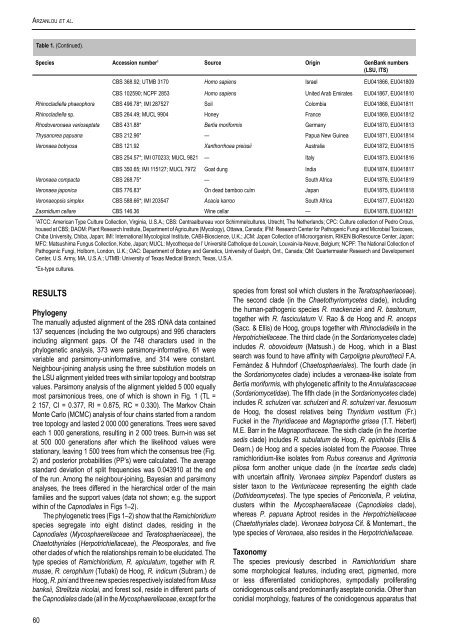The genus Cladosporium and similar dematiaceous ... - CBS - KNAW
The genus Cladosporium and similar dematiaceous ... - CBS - KNAW
The genus Cladosporium and similar dematiaceous ... - CBS - KNAW
Create successful ePaper yourself
Turn your PDF publications into a flip-book with our unique Google optimized e-Paper software.
Arzanlou et al.<br />
Table 1. (Continued).<br />
Species Accession number 1 Source Origin GenBank numbers<br />
(LSU, ITS)<br />
<strong>CBS</strong> 368.92; UTMB 3170 Homo sapiens Israel EU041866, EU041809<br />
<strong>CBS</strong> 102590; NCPF 2853 Homo sapiens United Arab Emirates EU041867, EU041810<br />
Rhinocladiella phaeophora <strong>CBS</strong> 496.78*; IMI 287527 Soil Colombia EU041868, EU041811<br />
Rhinocladiella sp. <strong>CBS</strong> 264.49; MUCL 9904 Honey France EU041869, EU041812<br />
Rhodoveronaea varioseptata <strong>CBS</strong> 431.88* Bertia moriformis Germany EU041870, EU041813<br />
Thysanorea papuana <strong>CBS</strong> 212.96* — Papua New Guinea EU041871, EU041814<br />
Veronaea botryosa <strong>CBS</strong> 121.92 Xanthorrhoea preissii Australia EU041872, EU041815<br />
<strong>CBS</strong> 254.57*; IMI 070233; MUCL 9821 — Italy EU041873, EU041816<br />
<strong>CBS</strong> 350.65; IMI 115127; MUCL 7972 Goat dung India EU041874, EU041817<br />
Veronaea compacta <strong>CBS</strong> 268.75* — South Africa EU041876, EU041819<br />
Veronaea japonica <strong>CBS</strong> 776.83* On dead bamboo culm Japan EU041875, EU041818<br />
Veronaeopsis simplex <strong>CBS</strong> 588.66*; IMI 203547 Acacia karroo South Africa EU041877, EU041820<br />
Zasmidium cellare <strong>CBS</strong> 146.36 Wine cellar — EU041878, EU041821<br />
1<br />
ATCC: American Type Culture Collection, Virginia, U.S.A.; <strong>CBS</strong>: Centraalbureau voor Schimmelcultures, Utrecht, <strong>The</strong> Netherl<strong>and</strong>s; CPC: Culture collection of Pedro Crous,<br />
housed at <strong>CBS</strong>; DAOM: Plant Research Institute, Department of Agriculture (Mycology), Ottawa, Canada; IFM: Research Center for Pathogenic Fungi <strong>and</strong> Microbial Toxicoses,<br />
Chiba University, Chiba, Japan; IMI: International Mycological Institute, CABI-Bioscience, U.K.; JCM: Japan Collection of Microorganism, RIKEN BioResource Center, Japan;<br />
MFC: Matsushima Fungus Collection, Kobe, Japan; MUCL: Mycotheque de l’ Université Catholique de Louvain, Louvain-la-Neuve, Belgium; NCPF: <strong>The</strong> National Collection of<br />
Pathogenic Fungi, Holborn, London, U.K.; OAC: Department of Botany <strong>and</strong> Genetics, University of Guelph, Ont., Canada; QM: Quartermaster Research <strong>and</strong> Developement<br />
Center, U.S. Army, MA, U.S.A.; UTMB: University of Texas Medical Branch, Texas, U.S.A.<br />
*Ex-type cultures.<br />
Results<br />
Phylogeny<br />
<strong>The</strong> manually adjusted alignment of the 28S rDNA data contained<br />
137 sequences (including the two outgroups) <strong>and</strong> 995 characters<br />
including alignment gaps. Of the 748 characters used in the<br />
phylogenetic analysis, 373 were parsimony-informative, 61 were<br />
variable <strong>and</strong> parsimony-uninformative, <strong>and</strong> 314 were constant.<br />
Neighbour-joining analysis using the three substitution models on<br />
the LSU alignment yielded trees with <strong>similar</strong> topology <strong>and</strong> bootstrap<br />
values. Parsimony analysis of the alignment yielded 5 000 equally<br />
most parsimonious trees, one of which is shown in Fig. 1 (TL =<br />
2 157, CI = 0.377, RI = 0.875, RC = 0.330). <strong>The</strong> Markov Chain<br />
Monte Carlo (MCMC) analysis of four chains started from a r<strong>and</strong>om<br />
tree topology <strong>and</strong> lasted 2 000 000 generations. Trees were saved<br />
each 1 000 generations, resulting in 2 000 trees. Burn-in was set<br />
at 500 000 generations after which the likelihood values were<br />
stationary, leaving 1 500 trees from which the consensus tree (Fig.<br />
2) <strong>and</strong> posterior probabilities (PP’s) were calculated. <strong>The</strong> average<br />
st<strong>and</strong>ard deviation of split frequencies was 0.043910 at the end<br />
of the run. Among the neighbour-joining, Bayesian <strong>and</strong> parsimony<br />
analyses, the trees differed in the hierarchical order of the main<br />
families <strong>and</strong> the support values (data not shown; e.g. the support<br />
within of the Capnodiales in Figs 1–2).<br />
<strong>The</strong> phylogenetic trees (Figs 1–2) show that the Ramichloridium<br />
species segregate into eight distinct clades, residing in the<br />
Capnodiales (Mycosphaerellaceae <strong>and</strong> Teratosphaeriaceae), the<br />
Chaetothyriales (Herpotrichiellaceae), the Pleosporales, <strong>and</strong> five<br />
other clades of which the relationships remain to be elucidated. <strong>The</strong><br />
type species of Ramichloridium, R. apiculatum, together with R.<br />
musae, R. cerophilum (Tubaki) de Hoog, R. indicum (Subram.) de<br />
Hoog, R. pini <strong>and</strong> three new species respectively isolated from Musa<br />
banksii, Strelitzia nicolai, <strong>and</strong> forest soil, reside in different parts of<br />
the Capnodiales clade (all in the Mycosphaerellaceae, except for the<br />
species from forest soil which clusters in the Teratosphaeriaceae).<br />
<strong>The</strong> second clade (in the Chaetothyriomycetes clade), including<br />
the human-pathogenic species R. mackenziei <strong>and</strong> R. basitonum,<br />
together with R. fasciculatum V. Rao & de Hoog <strong>and</strong> R. anceps<br />
(Sacc. & Ellis) de Hoog, groups together with Rhinocladiella in the<br />
Herpotrichiellaceae. <strong>The</strong> third clade (in the Sordariomycetes clade)<br />
includes R. obovoideum (Matsush.) de Hoog, which in a Blast<br />
search was found to have affinity with Carpoligna pleurothecii F.A.<br />
Fernández & Huhndorf (Chaetosphaeriales). <strong>The</strong> fourth clade (in<br />
the Sordariomycetes clade) includes a veronaea-like isolate from<br />
Bertia moriformis, with phylogenetic affinity to the Annulatascaceae<br />
(Sordariomycetidae). <strong>The</strong> fifth clade (in the Sordariomycetes clade)<br />
includes R. schulzeri var. schulzeri <strong>and</strong> R. schulzeri var. flexuosum<br />
de Hoog, the closest relatives being Thyridium vestitum (Fr.)<br />
Fuckel in the Thyridiaceae <strong>and</strong> Magnaporthe grisea (T.T. Hebert)<br />
M.E. Barr in the Magnaporthaceae. <strong>The</strong> sixth clade (in the Incertae<br />
sedis clade) includes R. subulatum de Hoog, R. epichloës (Ellis &<br />
Dearn.) de Hoog <strong>and</strong> a species isolated from the Poaceae. Three<br />
ramichloridium-like isolates from Rubus coreanus <strong>and</strong> Agrimonia<br />
pilosa form another unique clade (in the Incertae sedis clade)<br />
with uncertain affinity. Veronaea simplex Papendorf clusters as<br />
sister taxon to the Venturiaceae representing the eighth clade<br />
(Dothideomycetes). <strong>The</strong> type species of Periconiella, P. velutina,<br />
clusters within the Mycosphaerellaceae (Capnodiales clade),<br />
whereas P. papuana Aptroot resides in the Herpotrichiellaceae<br />
(Chaetothyriales clade). Veronaea botryosa Cif. & Montemart., the<br />
type species of Veronaea, also resides in the Herpotrichiellaceae.<br />
Taxonomy<br />
<strong>The</strong> species previously described in Ramichloridium share<br />
some morphological features, including erect, pigmented, more<br />
or less differentiated conidiophores, sympodially proliferating<br />
conidiogenous cells <strong>and</strong> predominantly aseptate conidia. Other than<br />
conidial morphology, features of the conidiogenous apparatus that<br />
60

















